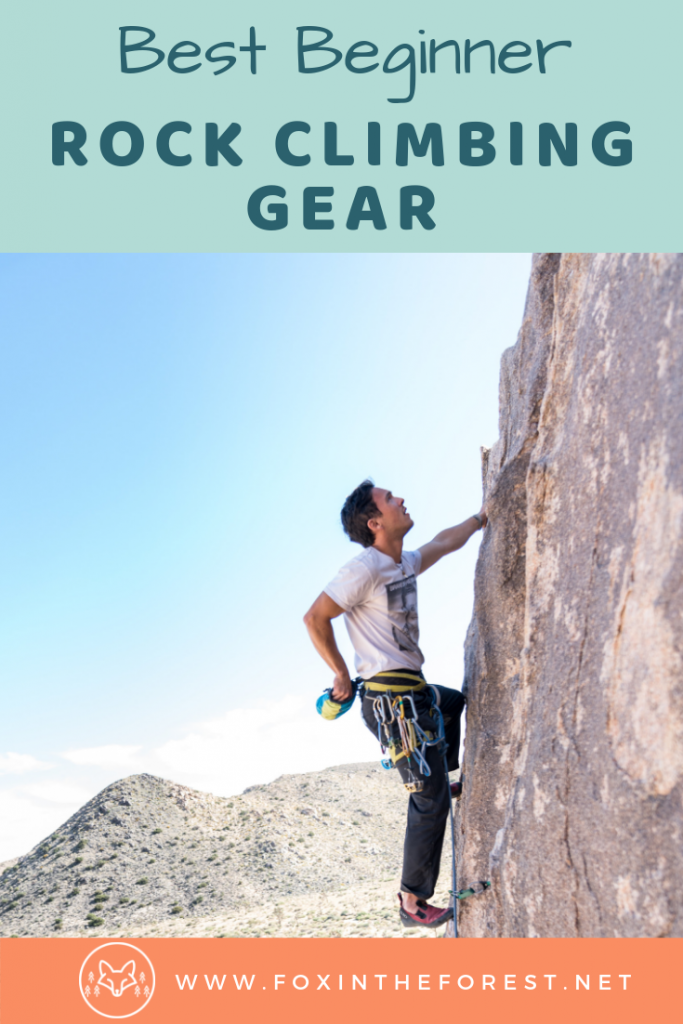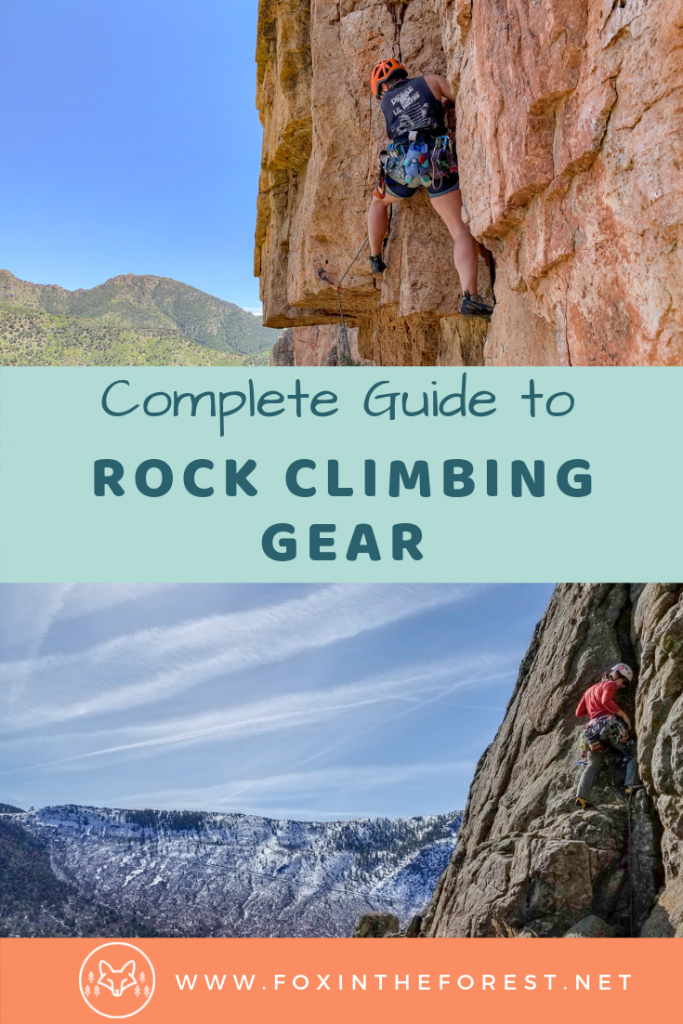Last Updated on November 22, 2019 by foxintheforest
To get started with rock climbing, you really don’t need to break the bank. A solid harness, a pair of shoes, a chalk bag and ATC is all you need to get started. I’ve spent the better part of four years using and testing various types of beginner climbing gear. Let’s get down and dirty with everything you need to get your climbing career off the ground.
What gear do you need to climb?
That depends on what you’re doing. If you’re climbing in a gym, you’ll just need shoes, a harness, chalk and bag, and a belay device.
If you plan on climbing outdoors and leading sport routes you’ll need:
- PPE: Belay device, harness, helmet
- Shoes
- chalk/chalk bag
- a single dynamic 60 or 70m rope (there are other types of ropes, called twin and double ropes, but that’s beyond the scope of this post).
- 16 – 20 quickdraws of varying length (explained below)
- a PAS or one double length sling for cleaning.
- 4 – 6 locking D-shaped carabiners. You can truly never have too many of these.
- 2 HMS locking carabiners (always carry one for backup). If you plan on multi-pitching, you’ll want two more.
- 2 double-length slings for anchors (you can get away with one, but with slings you can never have too many. They will get abandoned and wear out. With 2 you can multi-pitch.
- A hollow block or 7mm cord knotted into a prussik loop for rapelling.
How to Get Deals on Beginner Climbing Gear
First things first, buying used climbing gear is never a good idea. Since you don’t know the history of the gear, don’t purchase any safety gear second hand. This includes harnesses, protection, helmets, ropes, webbing or anchoring systems.
It’s best to buy new. In order to score a deal on climbing gear, get a list going and watch for sales. Lots of climbing gear goes on sale during the winter months, when more people are focused on snow. However, things like carabiners rarely lower in price, so be prepared to spend some cash.
How to Choose the Best Rock Climbing Shoes for Beginners
Footwear is highly personal. I am always hesitant to give footwear recommendations because feet are like snowflakes, each one is different. However, I will say that durability and reliability are two key elements to selecting good footwear. For your first pair of climbing shoes, you don’t need to drop hundreds on a hyper-aggressive slipper that will have you begging for a pair of high heels (dudes: read, high heels suck to walk around in).
For your first rock climbing shoe, look for something that fits properly, is flatter and less banana curved. Climbing shoes are inherently uncomfortable, so don’t be surprised if you can’t find anything you absolutely love. Your toes should be touching the outside of the shoe and it should feel tight, but nothing should be totally smashed. Since you rely on your toes for climbing, you want that contact with the shoe, since it will directly translate to contact with the wall.
Velcro versus laces is a personal choice. I like the convenience of velcro, but my newest pairs of Tenaya’s have laces. The laces give me more fit control, which is ideal for long, multi-pitch routes. Both Tenaya and Evo offer excellent entry and mid-level shoes. Evolvs are particularly durable and I’ve been wearing an intro level Evolv for nearly four years. They serve me well and continue to be my backup shoe when my cozy Tenaya’s are in the shop.
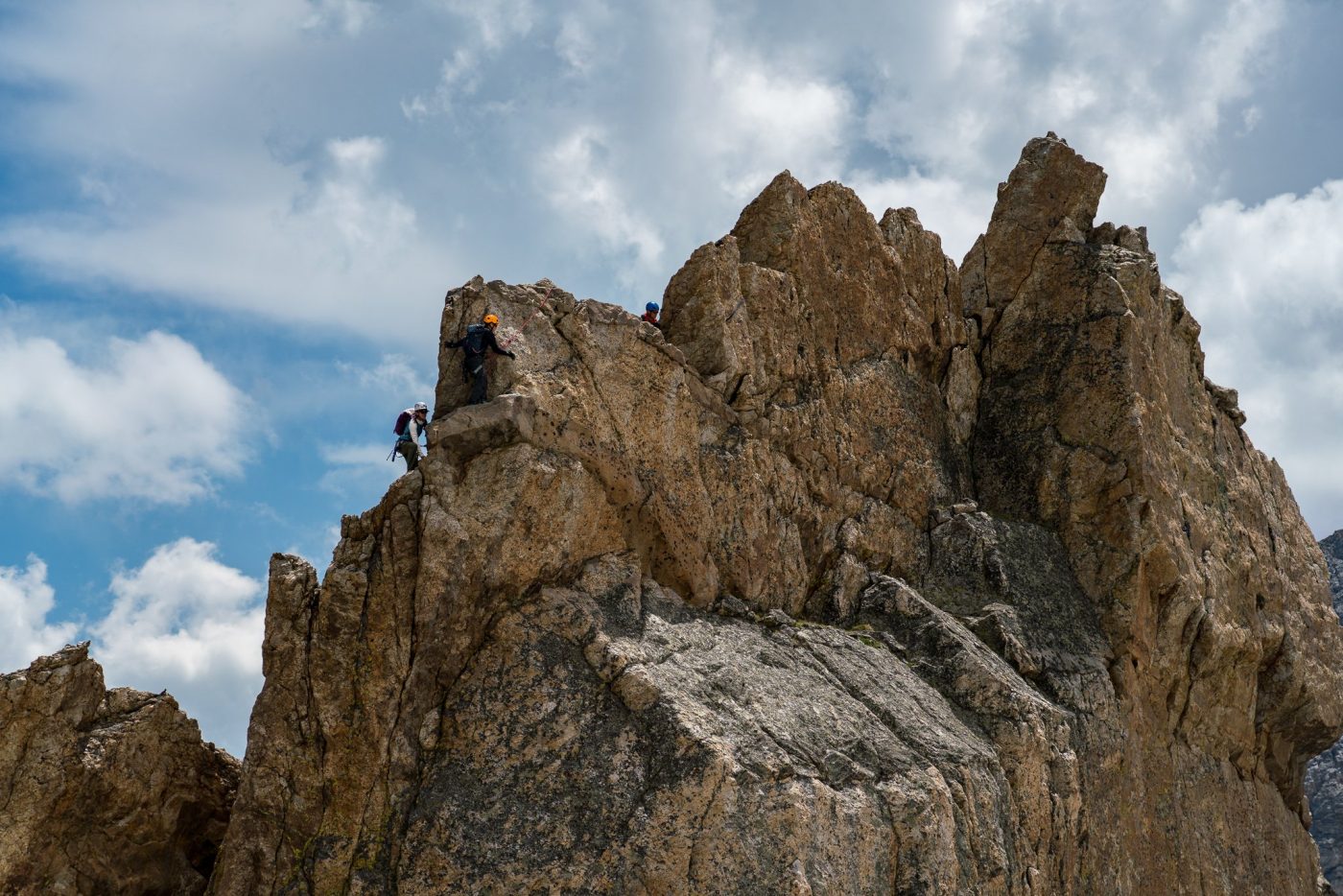
Climbing gear hurts the wallet, but the places it takes you is priceless. Image courtesy of Schyler D.
Pro Tip
Never buy climbing shoes over the internet, you won’t be happy. Go into a store and get fitted. Try on lots of different shoes so you can get a feel for what’s out there. Since climbing footwear isn’t like normal footwear, this will help you find the perfect fit. A good outfitter should let you climb a little on the wall to get a feel for the shoe. If you’re looking for a cheap pair, hit up a gym’s demo sale.
How to select a beginner climbing harness
Climbing harnesses vary across the board from an ultra-light alpine sender to the cozy gym cragger. Obviously, the lighter you go, the higher your price point. Harnesses are designed to last five years. So before you buy, think about what your ultimate climbing goal is. Are you interested in multi-pitch, high-alpine climbing? Do you want to use your harness in the winter? Are you simply looking to crag? Or maybe you just want to climb in a gym.
If you plan on spending a lot of time hanging in your harness on multi-pitch routes, climbing trad or sport outdoors, you want a harness that has a lot of padding where you need it. If the alpine is your thing, then the weight will also need to be considered (but remember weight = dollars). A good all-around harness will serve you well in multiple conditions. Just because you don’t have an alpine harness doesn’t mean you can’t climb with your harness in the alpine. It just means your harness may weigh a little more or fit goofy over your clothing.
The second thing to look at is features. Personally, I like a lot of gear loops. This helps me organize my gear at the crag and has me ready for anything. However, if you’re simply a gym climber, gear loops don’t really matter. The point is, select a harness that will work for what you want to be doing.
Pro Tip: Your harness should fit snug above your waist. Leg loops should be easy to slide snug. If you plan on climbing in cold temps, such as on snow or ice, make sure there’s some room to account for all the extra layers.
My Picks for the best climbing harness
Black Diamond Primrose Harness: This is my current harness. I’ve climbed on snow, in the alpine, multi-pitched, at the crag and in the gym. She has served me well over the years. This harness has all the gear loops and comfort you need, without breaking the bank.
Petzl Aquila: This is John (Squirrel’s) harness of choice. It’s cozy, durable, and lightweight. Perfect for sending pitches, rapping in the alpine or playing at the gym. The women’s Selena Sport by Petzl gets great marks as well.
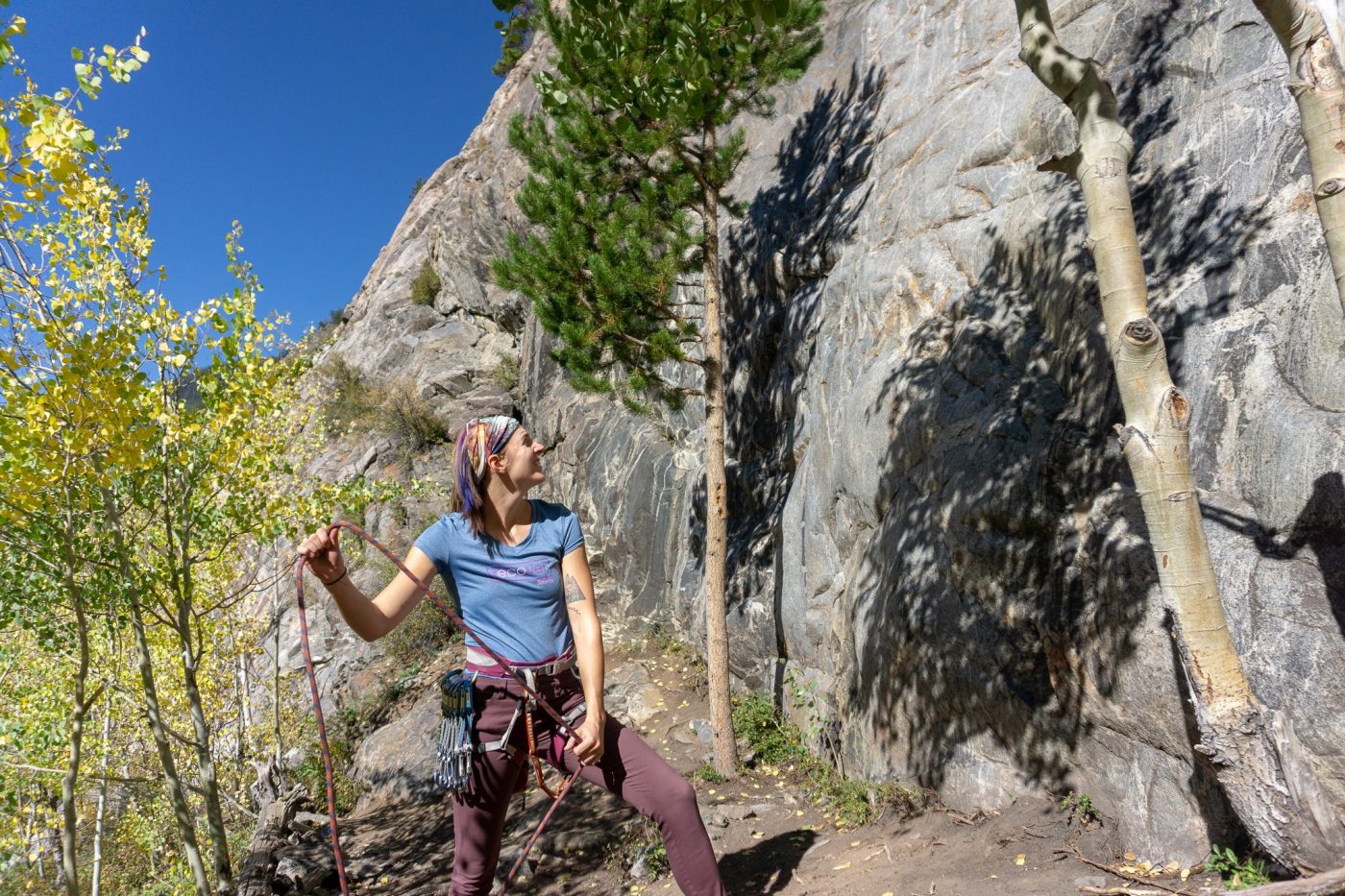
Just wearing a few of my favorite things. My BD harness has served me well from snowy ridge lines to desert canyons. It’s a workhorse and I’ll be sad to retire it next year. PS. This Mammut Protect rope is also one of my favorite pieces of gear.
The Best Chalk and Chalk Bag
Chalk and chalk bags are a personal preference. I love the chalk bag because it’s really about showing off your personal style I rock the EVO Sherpa cuz it’s got a fun, knitted pattern that I love. Anything that can clip to the ass end of your harness will work just fine. For chalk, I’m a Black Diamond White Gold gal myself. Again, this is largely due to personal preference, but the White Gold dries out my hands without causing cracking. It also clumps up slightly and I enjoy the satisfaction of breaking it up in my hands while I’m chalking up.
I buy chalk in bulk and use my Metolius Refillable Super Chalk Sock to refill my chalk. The sock keeps the chalk from getting all over the place and its ability to be reused is sustainable.
Pro Tip: Refill your chalk bag over a trash can or sink. It’s a messy business.
The Best Belay Device for Beginners
This is another item where you’ll want a little forward thinking. If you plan on multi-pitching then I would absolutely recommend the Black Diamond Guide. Go basic with the BD ATC Belay device. For something that gives a little more direction (making your belay and rappel easier) then check out the Big Air XP Belay Device Package. It looks more expensive, but it isn’t, you need to purchase a pear-shaped carabiner regardless, so this packaged item gets you ready to rock.
How to Choose a Climbing Helmet
Beginner climbers shouldn’t worry about choosing the lightest alpine helmet on the market. Instead, opt for something that is utilitarian that will keep you safe. Make sure you buy the correct size. The helmet shouldn’t slip or tilt a whole lot on your head. Many helmets have adjustments as well. Remember to replace your helmet if you encounter any significant rock fall or hits to the head, otherwise, the helmet might not work properly.
Pro Tip: If you do have a crushing helmet incident, contact the manufacturer. Manufacturers stand behind their product and if your helmet gets totally trashed from a fall, they may send you a new one. It’s always worth a try.
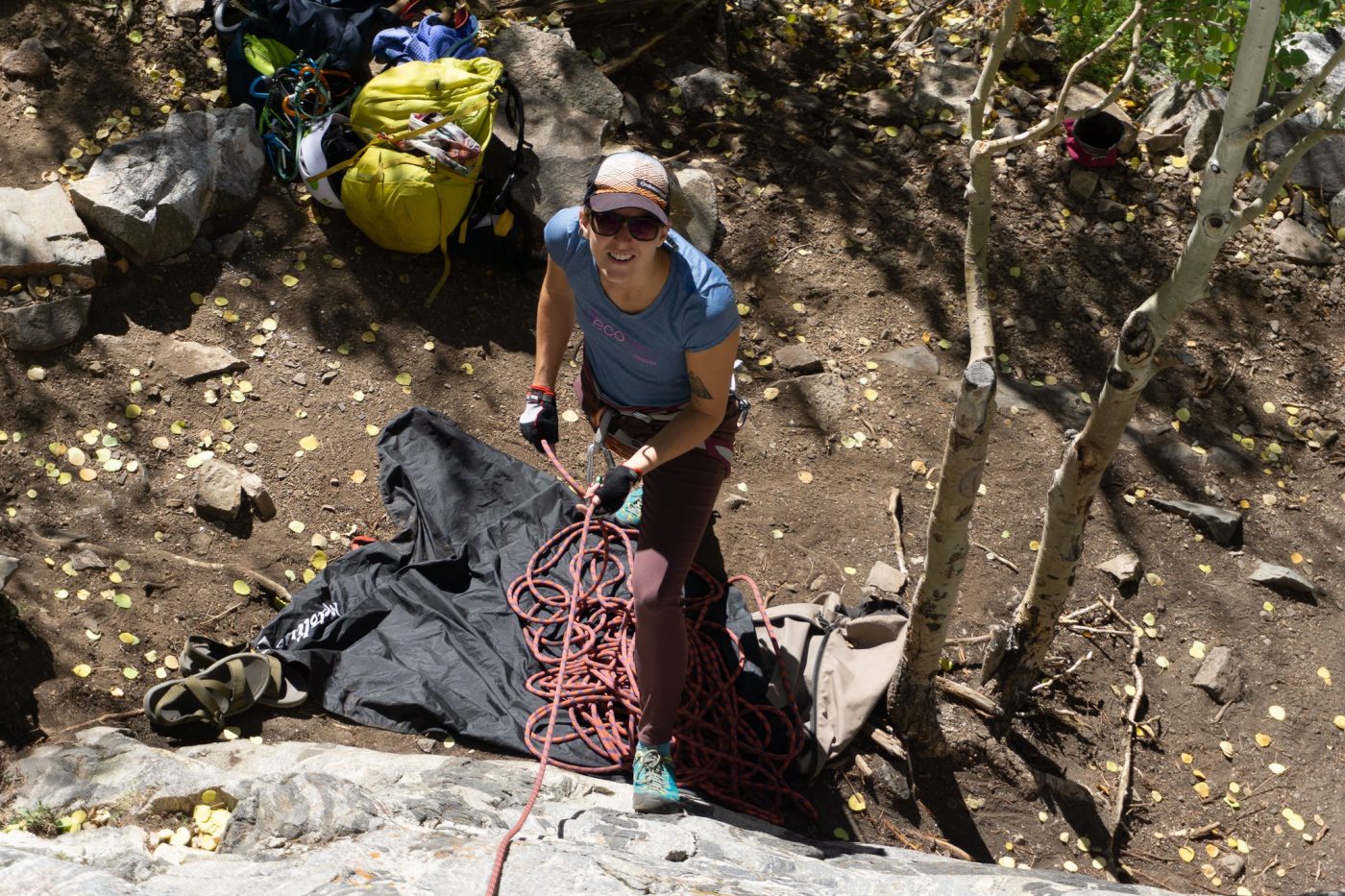
The most important aspect of a belay device is the person using it. Always learn how to safely belay before heading outside.
Send-tastic Carabiners
Honestly, I could write a dissertation about carabiners. These are metal devices are engineered and rated to help aid you in your climbing endeavors. I won’t bore you with too many details (if you want to learn more, this article explains the different types pretty darn well), but when you first start climbing, you only really need one carabiner for your belay device. This should be a pear-shaped, locking carabiner. I recommend either the BD VaporLock Screwgate Locking Carabiner or the wider CAMP USA HMS Compact Carabiner. The ladder is a bit fatter and heavier, but the rope slides more smoothly.
How to Select a Beginner Climbing Rope
Your rope costs a pretty penny. Lucky for you, beginner climbing ropes are typically bigger, heavier and therefore cheaper. You’re going to want a workhorse rope that’ll handle anything you throw at it when you start out. When you transition from indoor to outdoor climbing, there is a learning curve when it comes to rope maintenance. You need to be aware of rope drag, select draws that are going to help alleviate tension, etc. The point is, you’ll want to start with a durable rope that will help you as you learn.
Depending on how often you climb, you could replace your rope every year, therefore, this purchase should be made with your current experience level and needs in mind. For the beginner climber, you will likely be climbing top rope or leading single-pitch sport routes outdoors. You’re also not as well-versed in advanced belay techniques. Therefore, look for a rope that’s in the 9.8 to 10+mm range. The fatter the rope, the more durable it is, the more falls it can handle and the easier it is to belay. However, that means it’s heavier, which isn’t always good for long, multi-pitch routes or trips into the alpine.
Start with a single rope that has high kudos for durability. I recommend either the Elderid Boa Eco 9.8 non-dry or the Mammut Eternity Protect 9.8. I’ve sent countless pitches on both of these workhorses and they are excellent ropes. Both have an in-factory butterfly coil so they don’t twist up into an unruly mess. The Boa Eco gets accolades for being the first Bluesign certified rope (yay sustainability), but its white-ish sheath means it gets dirty quickly, making it difficult to see the half mark. The Mammut can take a serious beating with its protective technology. I’d purchase another Mammut in a heartbeat.
Pro Tip
Opt for a 70m rope. This will enable you to handle almost all climbing routes outdoors. Also, if you don’t want to fork out the cash for a rope bag, use an IKEA bag or a large reusable grocery bag to flake your rope out in.
Slings, Cord, and Webbing
If you are going to top rope or sport climb outdoors, you’ll want a way to build anchors. For sport, you can often use two quick draws, but that’s not always the case. In Vedauwoo we encountered bolted sport anchors that required the use of slings. If you’re ever on multi-pitch, you’ll want the ability to build an anchor from slings. Here’s what you’ll need to get started outdoors on sport.
- Two double-length slings (always good to have a backup!). These can be Dyneema or nylon.
- One single-length sling, great for racking gear to and from the crag.
- Longer webbing pieces (think 20 feet) for any alpine rappels or top rope anchors (again, Dyneema or nylon).
- PAS or personal anchoring system. Although technically not required, I love my PAS. I use these instead of single-length slings to clean and anchor in.
- 20 feet of 6mm cordalette. You can use this to build multi-pitch anchors. You can build anchors using webbing, but this is another option to consider.
- Hollow block or three feet of cordalette made into a prusik loop. For cleaning and rappelling. Hollow blocks are rad because they work when wet and are pretty indestructible.
Keep in mind, Dyneema is a lighter, smaller material, but there is an argument out there that if Dyneema is put under extreme forces, it can cut itself. Never leave knots in slings, remove them for storage after you’re done cragging.
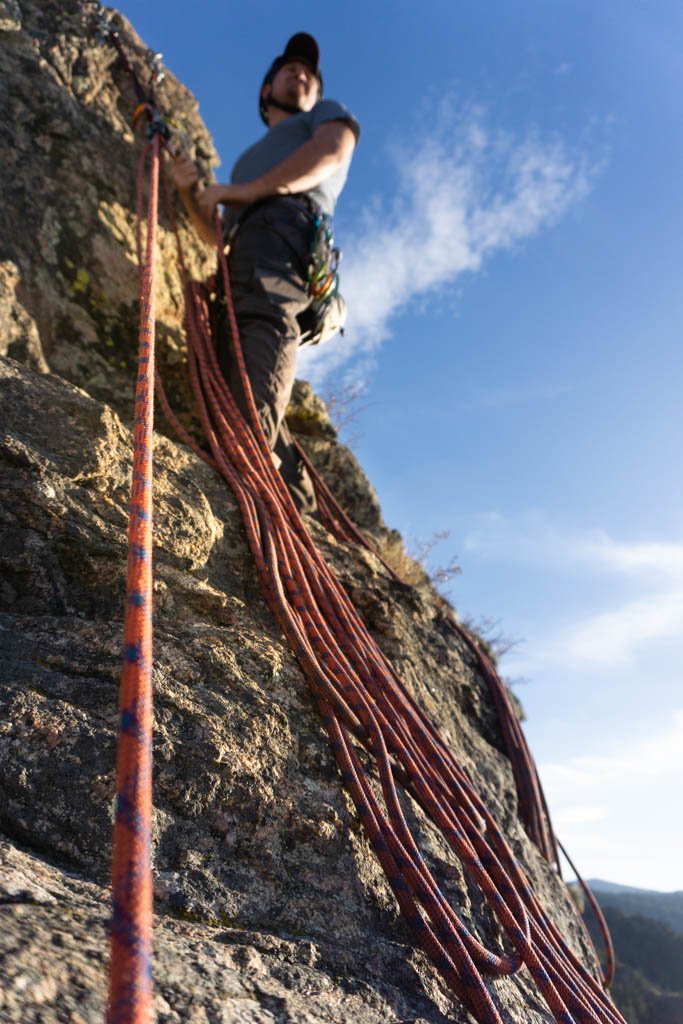
Sending pitches and enjoying the view.
What to Wear at the Crag
Wardrobe decisions at the crag vary from the shirtless man-sender to climber casual. At a bare minimum, make sure your clothing isn’t too loose. You don’t want a shirt or pants to get caught in equipment. I personally love my PrAna Briann pants or a pair of cheap leggings. I’ll pair that with a tank top and a cozy pair of belay shoes (think comfy sneakers or sandals) and away I go. Typically I’d prefer to climb in pants in order to protect my legs and keep shorts from riding on my harness. The point is, wear something that allows free movement of your legs. Stiff jeans will have you begging for more extension in your legs.
Pro Tip: Tuck in your shirt and wear clothing that contrasts against the color of rock you climb in order to look good in pictures.
Best quickdraws for beginner lead climbers
If you’re just jumping into lead, I would recommend picking up 16 to 20 quickdraws. How forward thinking you’d like to be is up to you. Wiregates will be lighter, but pricer. Going full alpine will only frustrate you when you start out, so keep it simple. Head to the store and play with the clips. Think about the ease that you can clip a rope through the draw. Each draw is a little different. I’ve got a few different manufacturers in my arsenal. I recommend getting mostly 14cm draws a pack of four 16cm draws and a pack of 4 alpines. A few solid, well-priced quickdraw options are:
- CAMP USA Orbit Express (come in multiple sizes and the wire gates are good too)
- Trango Phase Alpine Draws
- Black Diamond Free Wires
How Many Carabiners do you need to lead climb?
Now that we’ve covered quickdraws, slings and webbing let’s talk carabiners. If you’re building anchors with webbing, multi pitching or using a PAS or other type of sling anchor system for cleaning, then you’re going to need a few quickdraws. Here are the carabiners you need to send:
- 6 D-shaped lockers. Hands down the best carabiner to get the job done is the CAMP USA Photon. It’s small, lightweight and inexpensive. Use these to build anchors, anchor in with your PAS, or create your autoblock. Six will get you two full anchors (it’s always good to have a backup in case you drop something) and anchor in with your PAS.
- 4 pear-shaped, HMS lockers. One for your ATC, one for guide mode (multi-pitching), one to anchor in using a clove hitch (multi-pitching) and one because you will lose one. I let one fly off the side of a mountain while climbing the Citadel.
- accessory carabiners. These don’t need to lock and hold accessory items like a small water bottle, pair of gloves or shoes.
In reality, if you aren’t climbing outdoors, you just need shoes, harness, ATC with an HMS locker and a bag-o-chalk. Once you get into outdoor climbing, that’s when you’ll need to investigate the remaining beginner climbing gear on this list. So go forth and happy sending!
